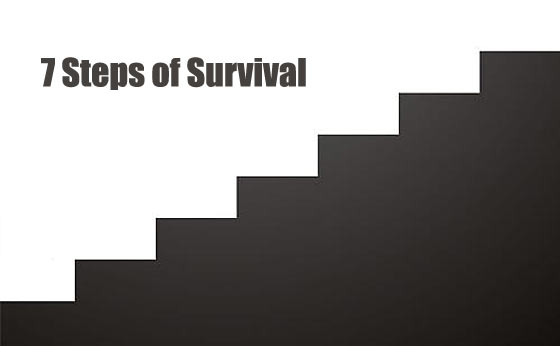The 7 Steps of Survival

“A few decades ago I took a series of wilderness survival courses through Sea-Grant and our local community schools program. I live in coastal Alaska, and the classes were intended to teach survival in high stress wilderness and marine emergency situations, cold-water survival, CPR, wilderness first aid, survival pack, and numerous others. The one that seemed to have universal meaning to me was the 7 Steps of Survival.”
(Guest article by a Modern Survival Blog Reader)
I found the 7 steps to survival to be much more wide-ranging than just wilderness survival. I’ve applied them to every aspect of my life, and taught them to my son and now my grandson.
I will share the 7 steps of survival and try to give some examples on their usefulness, both in survival situations, and as a general guide to life and prepping. I will also try to relate the steps to the law of threes and some other prepper themes:
7 Steps Of Survival:
Recognition, Inventory, Shelter, Signals, Water, Food, Play
Survival Step 1: RECOGNITION
“The first step to surviving is recognition.” I have pounded that sentence into my and my son’s heads to the point it has become instinct. Of course one cannot take definitive action to insure one’s survival until one recognizes one is in this situation. So simple but soooo overlooked.
The first few seconds and minutes are critical. It doesn’t matter if one is dealing with a boat sinking in cold water, a bear charging, investing in food storage, stocks, gold, bullets, SHTF, no action to mitigate the threat can begin until it is recognized as a threat. (Don’t we all have family and friends who just have no recognition skills?)
Recognition is the essence of situation awareness, the antidote to normalcy bias, in the woods we call it heads up.
Survival Step 2: INVENTORY
How big are the waves? How far from shore are we? Cold water? Where is my survival bag, life vest? What is in my pockets? Who is with me? Are they in recognition, injured, can they swim, run, walk, shoot? Any other boats around? Are they friendly?
Inventory should be applied as broadly as possible. In a situation of SHTF, if you are away from home, inventory could mean your vehicle, route, alternative routes, the condition of the grid, GHB, where your family is, what and where is the threat. Mentally inventory everything and its application to your situation.
Survival Step 3: SHELTER
Keep your body heat, keep cool, keep dry, find cover.
What is the threat to your body or who might be after you that you may need to hide from? Evaluate the threat and insulate yourself from it. I would say having a weapon and knowing how to use it comes under shelter.
Cover, concealment, body armor, gas mask, pandemic protection, rubber gloves, a garbage bag, any type of protection falls under shelter.
Survival Step 4: SIGNALS
Communications radios, cell phones, signal mirrors, flares, three fires on the beach, but also in a crowd or dark ally body language.
Do I look like a mark? When confronted by danger, human or animal what signals do I send out? What signals do I want to send and what signals do I not want to send. Also, what signals are present in my environment, tire tracks, bear tracks, dark clouds, an angry mob?
Survival Step 5: WATER
Average person can live only 3-4 days without water; need to acquire clean, plentiful water source.
[ Ken adds: As most of you know, WATER is VERY important for survival! There are tons of articles here on the blog about this topic. ]
[ Read: Stainless Steel Canteen – Single Walled for Boiling Water ]
Survival Step 6: FOOD
Important to meet energy needs and keep up spirits.
[ Ken adds: Although not as immediately critical as Water, FOOD provides essential ENERGY during a survival situation! ]
Got emergency foods in your kit?
[ Read: About the DATREX Food Bar ]
[ Read: About the CLIF Energy Food Bar ]
Survival Step 7: PLAY
Step 7 is so important. In so many survival situations the person who lives is the person with the right mindset. In a prolonged SHTF scenario morale is make or break. “Reinforces a positive attitude which strengthens the will to
survive.”
[Ken adds: I found this resource from the United States Coast Guard. A teaching guide outline for the 7 steps of survival. It sheds a little more light on the subject ]
The Rule of Threes
[ Read: The Rule of 3’s ]
A long cherished tool of survival works closely with the seven steps.
1, Recognize, “Oh crap.” You can live three seconds without thinking.
2, Inventory, “I can’t breath.” Three minutes without air.
3, Shelter, Three hours without shelter.
4, Signals,
5, Water, Three days without water.
6, Food, Three weeks without food,
7, Play, Three months without friends.
It is vital to imprint the steps. Keep them in your mind through a few days and see how they apply to your daily activities. They are a tool intended to be effective under pressure on a deep level like muscle memory. They are intended to be applied as broadly as possible.
When things get dicey recall the steps and start adapting them to your reality. They are a roadmap for survival adaptable to nearly every situation.
The seven steps are among the finest tools in my mental every day carry bag.
